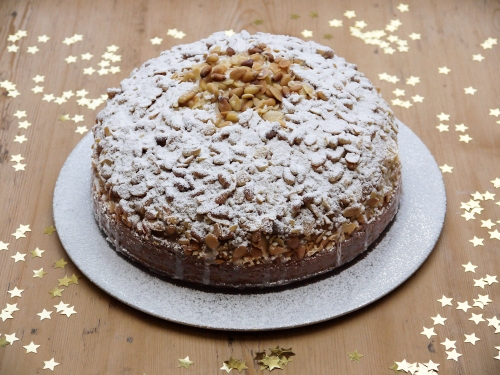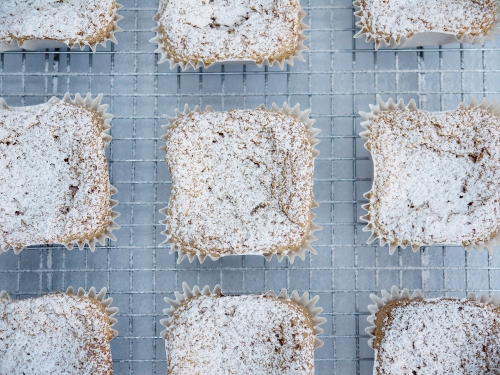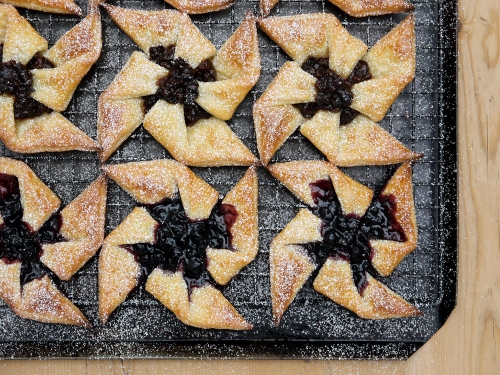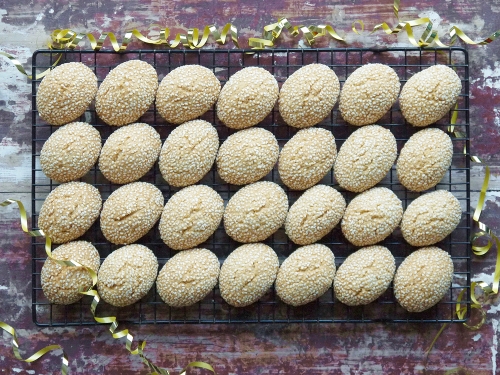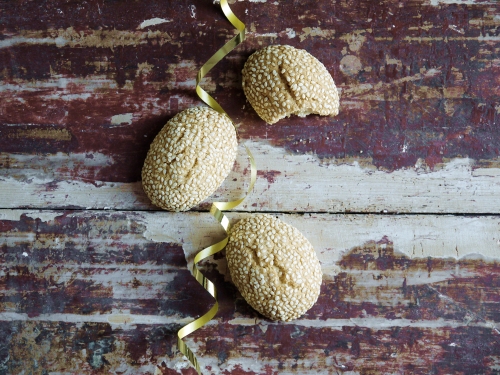And here we are! The final installment of 2016’s edition of the Twelve Bakes of Christmas!
Today I’ve turned my hand to a very traditional Italian cake, the Nadalin de Verona. This is a rich dough raised with yeast, which should hint that it has a long history, pre-dating our modern raising agents. It is flavoured with butter, vanilla and lemon zest, and topped with pine nuts, chopped almonds and sugar.
It is fair to say that the big name of the Italian festive cake world is the panettone, closely followed by the pandoro. I make panettone fairly often, as it is easy with a bread machine and it always proves popular. However, I’ve never had a go at pandoro. The name means “golden bread” and it gets this colour from many, many, many egg yolks in the dough. I’m sometimes a very lazy baker and don’t like ending up with lots of spare egg whites. I guess I’ll get round to making a pandoro the next time I have to make a pavlova…
But back to the star of today. The nadalin (also called the “natalino”) dates back as far as the 13th century, and is suggested as the ancestor of the modern pandoro. It is said to have been created to mark the investiture of the Della Scala family as the Lords of Verona. It is often linked to the most famous tragic romance of all time – the nadalin appears first in 1303, the same time that the events of Romeo and Juliet as said to have taken place. I’m not clear quite what the link is, but this cake may have featured on a medieval banquet table where either of the star-crossed lovers were present.
Now, in the interests of Christmas, I’ve actually made the nadalin not just once, but twice!
I looked at a few recipes before making the nadalin, and settled on the “authentic” version on the website of the City of Verona tourist office. However I am sorry to say it didn’t quite work for me. It is made from eggs, a lot of butter and quite a bit of sugar. My baking instincts said this would be a very rich dough and the yeast might struggle to get a good rise, and it turned out to be so. It was of course perfectly tasty, but it didn’t have the lightness I prefer from sweet breads. This is all personal preference, but what to do?
Well I mentioned that I make panettone quite often, so I looked at my own recipe and adjusted to reflect the flavours of the nadalin – out with the dried fruit, and in with the vanilla and lemon zest. I also added a small handful of crushed sugar cubes to add some additional sweetness to the dough. Entirely optional, but this seemed like a sensible way to get a bit more sugar in the dough without making it too rich to rise well. I’m pleased to say this all worked very well, and the result is a light, sweet and fragrant festive bread.
To finish the nadalin, it is brushed with melted butter and topped with pine nuts and chopped almonds. They were a delicious addition, as they toast during baking to provide some crunch and flavour contrast.
Traditionally the nadalin is baked in a star shape. However I’ve bought so many pieces of baking equipment recently that I had to make do with the round cake tin I already had. To make up for my cake being the “wrong shape” I made a simple star template and placed it on top of that nadalin before dusting with icing.
The nadalin is traditionally enjoyed with cocoa or a special wine after Christmas Eve mass. I would also quite happily much on a piece of this on a chilly winter evening too!
And with that, my 12 Days of Christmas Baking is over for 2016. I hope you’ve enjoyed it – I’ve enjoyed finding new inspiration, trying new baking techniques and eating the results! See you for the 2017 edition – if you have any suggestions of local specialities that I should try, leave a comment below.
To make a Nadalin de Verona (nom-traditional)
For the dough:
• 2 eggs
• 150ml milk, boiled and cooled
• 75g butter
• 50g sugar
• Zest of 1 lemon
• 1 teaspoon vanilla extract
• 1 1/2 teaspoons dried yeast
• 400g strong white flour
• small handful of sugar cubes, crushed
To decorate:
• melted butter, to brush
• 50g pine nuts
• 50g chopped almonds
• 20g pearl sugar
To finish:
• 100g icing sugar
• water
• icing sugar, to dust
1. Make the dough – I used a bread machine for all the hard work. Put everything apart from the sugar cubes into the bread machine. Run the dough cycle.
2. Crush the sugar cubes. Work into the finished dough.
3. Line a cake tin (or wide saucepan) with greaseproof paper. Take the dough out of the machine, form into a ball, and press into the tin. Leave in a warm place, loosely covered with clingfilm, until the dough has doubled in size. Traditionally this is for 3 hours, but as my recipe is lighter, this could happen more quickly.
4. Just before you’re ready to bake, preheat the oven at 180°C (350°F).
5. Now prepare the topping. Melt some butter, and mix the pine nuts, flaked almonds and pearl sugar in a bowl.
6. Brush the nadalin generously with the melted butter. Sprinkle over the nut mixture and press down very gently.
7. Bake the nadalin for around 45 minutes to an hour until risen and golden, and it sounds hollow when tapped. If the nuts are browning too quickly, cover loosely with tin foil.
8. When baked, remove the nadalin from the oven. Make a simple icing with 100g icing sugar and 3 tablespoons of boiling water, and drizzle on top of the nadalin – this will form a glaze, and help keep the nuts in place.
9. Leave to cool completely, then dust with icing sugar before serving. I used a star template as a nod to the traditional shape.


